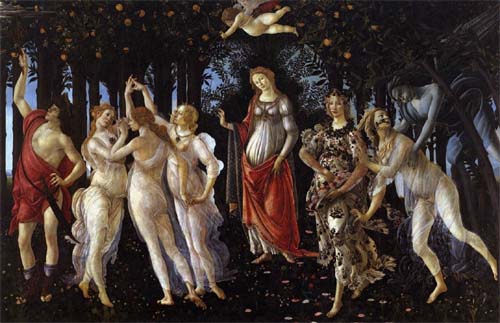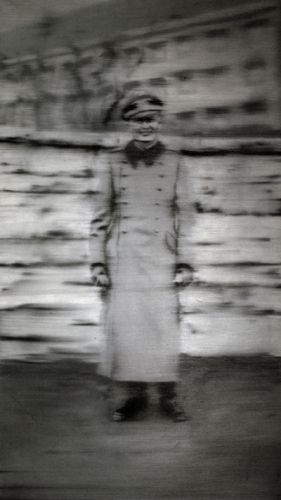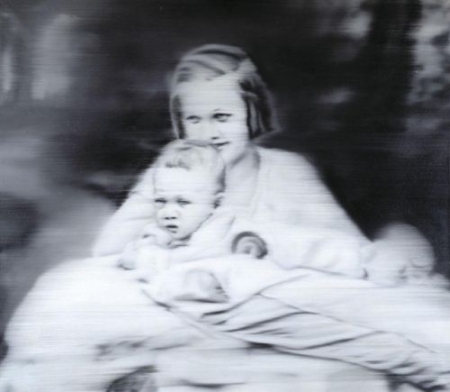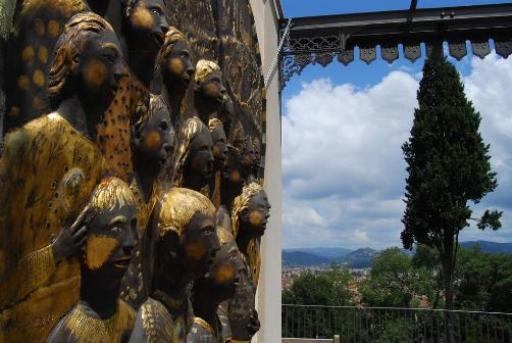Continuing from last week’s post, which looked at three great paintings with dark backgrounds, Malty expands, taking in Richter, understrappers and the meaning of art…
There is another dimension to these three paintings, in that they reside in what must be their natural setting. Mrs Ionides, from an era when the ‘if you have it, flaunt it’ movement was gathering pace now hangs in an area of London where conspicuous consumption dominates.
The Old Lady With The Candle lives in Köln, the home of the greatest living artist, Gerhard Richter, whose early life influenced his work.
Richter’s picture Onkel Rudi [above], overpainted in 1965, is surely saying “pay attention to how you use your time”. (For some time Uncle Rudi resided in the Ludwigs museum, a ten minute walk away.) Gerhard’s uncle, standing so proudly in his field grey uniform died in late July 1944, still in uniform. Richter was the second German artist to start his career using his wartime experience (the first was Joseph Beuys), at the time a taboo subject.
Tante Marianne is above: the second 1965 picture is of Gerhard’s aunt, holding him, aged 4 months, in June 1932. She died 13 years later, a victim of the Nazi’s euthanasia programme, she was deemed “a burden to society” Again the hint of a warning “pay attention to how you use your time”.
Botticelli’s Primavera [top] is where it should rightly be, in its natural home, close to its place of birth, the ghostly sound of snoring understrappers drifting up from the banks of the Arno.
Some additional items:
Regarding understrappers
Understrappers being what understrappers are, clangers, dropped goolies, painting feet with four toes, visibly erect todgers etc, they were frequently harshly dealt with: miscreants who dared slope off for a snooze down by the Arno were dealt with severely.
These are Florentine bodega understrappers, caught dozing, frozen in carbon, hung on the wall of what is now the Bardini garden’s Roberto Cappuci Museum and condemned to look out over Firenze’s duff end, in perpetuity…
Regarding Silvia Piccollo (L’Euridice’s La Tragedia)
Silvia Piccollo is, unfortunately, seldom heard. She can however be found on the Bongiovanni label singing the part of Primavera in Domenico Scarlatti’s La Contesa Delle Stagioni (the dispute of the seasons) described in the Gazeta de Lisboa as ‘an excellent serenata in Italian’, composed for the birthday of the queen of Portugal, Maria Ana Josefa, in September 1720. The serenata is a pure joy, as is Silvia’s singing. Autumn, the tenor Vitro Martino is another joy and reminds me of the singing that Mackerras coaxed from his Edinburgh Festival tenors, delighting the Usher Hall audiences with those unforgettable Mozart performances during the nineteen nineties, before the RBS and its corporate parasites arrived and ruined the joint.
A small plug for the Bardini Garden
The garden, opened in 2005, after falling into disrepair, is one of the Florentine hidden gems, accessed by crossing the Ponte Vecchio, turn left, two minutes , turn right through the arch, up the Via Della Costa San Giorgio towards the Belvedere, past the fort’s wall, the garden’s entrance is on the left, in a cobbled lane. Well worth the climb, a haven of rest, grockle free, much better than the over-hyped, overcrowded Boboli. Contains the Roberto Cappuci Museum, fashion as art according to Frau M, who still has a collection, awaiting revival. Although there may be a nod in the direction of high days and holidays and bonfire nights.
Disclaimer
Don’t blame me for any inconsistencies in the third item, I’m just a simple engineer, there is some controversy here. So, regarding who and when, Hibbert’s The rise and fall of the house of Medici and is used as the backstop, maybe. Obviously the dark backdrop gubbins was merely an excuse for a significant genuflection at the early Italian renaissance, crackin’ stuff that it is, as Fra Filippo said to Sandro when showing him the ropes “good ‘ere mush, innit.”















Richter the greatest living artist… the more I see of GR, the more I’m inclined to agree with that assessment. Are there any other contenders?
Thanks Malty, for this typically off-centre view of a world even more difficult to understand than it ever was, and these days seemingly more concerned with ‘cool’ than with competence. In my own modest (I hope) contributions to these pages I try to stay away from ‘greatest’, as surely in artistic endeavour (as much as in sport, say), it is almost meaningless – no? Jasper Johns and Richard Serra are still alive, I think; work by both of them has met my criteria for defining art (moving me from one place to another place); they are therefore, for me, important artists, as is Richter, and if I were fortunate enough to own any of their work, and I were concerned only with the market value of my investment, I would not be considering unloading into the market any time soon. If however I had been stupid enough to buy a ***** (take your pick, Dabblers) a few years ago, I would be calling Sotheby’s this morning.